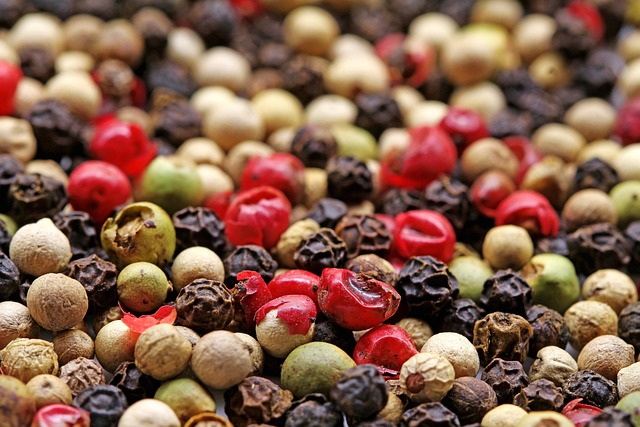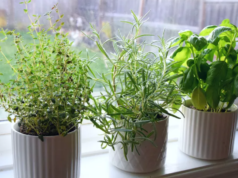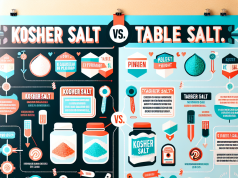Contents
A Closer Look at White Pepper: History, Varieties, and Cooking Techniques
White pepper is a popular spice used in various cuisines around the world. It is derived from the same plant as black pepper but with a different processing method, resulting in a distinct flavor and appearance.
History
The use of white pepper dates back thousands of years and has been an essential ingredient in traditional Chinese, Indian, and European cooking. It was highly valued for its medicinal properties as well.
In ancient times, white pepper was considered a luxury spice and was often used by the wealthy elite. Its demand grew during the medieval period, and it became a valuable commodity in international trade.
Varieties
White pepper is available in different varieties, each with its unique characteristics. The most common types include:
- Muntok White Pepper: Originating from the Indonesian island of Bangka, Muntok white pepper is known for its mild, delicate flavor.
- Sarawak White Pepper: Grown in Malaysia, Sarawak white pepper has a stronger and spicier taste compared to Muntok variety.
- Lampung White Pepper: Lampung white pepper comes from Sumatra, Indonesia, and is known for its fruity and earthy notes.
Cooking Techniques
White pepper is widely used in both savory and sweet dishes. It adds a subtle heat and depth of flavor to soups, sauces, stir-fries, and marinades. Additionally, it is a popular choice for seasoning creams, mashed potatoes, and other creamy dishes where the black specks of black pepper may appear visually unappealing.
When using white pepper in recipes, it is generally recommended to add it towards the end of the cooking process to best preserve its delicate flavor. It is also preferred in dishes where the black specks of black pepper may disrupt the visual appeal, such as light-colored soups or sauces.
Overall, white pepper is a versatile spice that adds a unique taste to a wide range of dishes, making it a staple in many kitchens worldwide.
A Closer Look at White Pepper: History, Varieties, and Cooking Techniques
History of White Pepper
White pepper is a spice commonly used in various cuisines around the world. Its history dates back centuries, with its origins traced to Southeast Asia. Initially cultivated in India, white pepper quickly gained popularity and spread to other parts of the world through trade routes.
Varieties of White Pepper
White pepper comes in different varieties, each with its own distinct characteristics. These varieties include:
- Muntok White Pepper: This is the most common and widely available variety. It is named after the Indonesian port of Muntok, where it was originally harvested.
- Sarawak White Pepper: Harvested in the Malaysian state of Sarawak, this variety is known for its strong aroma and subtle heat.
- Lampung White Pepper: Grown in the Lampung province of Sumatra, Indonesia, this variety is often considered more pungent and aromatic than others.
Cooking Techniques and Uses
White pepper is a versatile spice used in numerous recipes around the world. Here are some popular cooking techniques and uses:
- Ground White Pepper: Most commonly used in dishes where its flavor can shine, such as creamy soups, mashed potatoes, and white sauces.
- White Pepper Marinades: White pepper is an excellent addition to marinades for meat and poultry, adding a subtle yet distinct flavor.
- Southeast Asian Cuisine: White pepper is a staple in many Southeast Asian dishes, adding heat and depth to curries, stir-fries, and noodle recipes.
Relevant Post: Benefits of Using White Pepper in Cooking
Looking to learn more about the benefits of using white pepper in your recipes? Check out our related blog post for valuable insights and cooking tips.
Conclusion
White pepper has a fascinating history and offers various varieties to explore. Its unique flavor profile and versatility in cooking make it a valuable spice in many cuisines. Whether you’re a seasoned chef or an aspiring home cook, be sure to include white pepper in your spice collection to enhance the flavors of your dishes.
A Closer Look at White Pepper: History, Varieties, and Cooking Techniques
1. What is the history of white pepper?
White pepper has a long history that dates back centuries. It was first cultivated in Southeast Asia and has since spread to other regions around the world.
2. What are the different varieties of white pepper?
There are several varieties of white pepper available, including Indonesian, Vietnamese, and Malaysian. Each variety has its own unique flavor profile and characteristics.
3. How is white pepper used in cooking?
White pepper is commonly used in a variety of dishes, including soups, sauces, and marinades. It offers a more delicate and subtle flavor compared to black pepper.
4. What are the health benefits of white pepper?
White pepper is known to have antioxidant properties and may help improve digestion. It is also believed to have anti-inflammatory effects and can aid in boosting the immune system.
5. Are there any cooking techniques specific to white pepper?
White pepper is often used in dishes that require a lighter appearance, as it blends well with lighter-colored ingredients. It is also commonly used in Asian cuisine for its unique flavor profile.
Exploring the Versatility of White Pepper in Cooking
What is White Pepper?
White pepper, derived from the same plant as black pepper, is a popular and widely used spice in various cuisines around the world. It is made from fully ripe peppercorns that are soaked in water and then their outer skins are removed before drying. This process gives white pepper a milder and less pungent flavor compared to black pepper.
Enhancing Flavors with White Pepper
White pepper is a fantastic ingredient for adding a subtle heat and depth of flavor to a wide variety of dishes. Its unique taste is well-suited for creamy soups, sauces, and marinades. Unlike black pepper, white pepper doesn’t visually impact light-colored dishes, making it an ideal choice when you want to avoid specks of black in your final presentation.
Recommended Cooking Techniques
- Dusting: Sprinkle a pinch of white pepper over freshly prepared salads, roasted vegetables, or mashed potatoes for an extra burst of flavor.
- Infusing: Combine whole white peppercorns with other aromatic spices to create a flavorful broth or a marinade for meats.
- Grinding: Grind white peppercorns using a pepper mill or a mortar and pestle to unlock their full flavor potential. You can then use the freshly ground white pepper in a variety of dishes such as stir-fries and sauces.
Health Benefits and Side Effects
Aside from its culinary uses, white pepper also offers certain health benefits. It contains potent antioxidants and may aid in digestion, act as a natural decongestant, and even help boost metabolism.
However, it’s important to note that excessive consumption of white pepper can cause gastrointestinal discomfort for some individuals. It is always recommended to use it in moderation and consult with a healthcare professional if you have any specific concerns.
Explore the White Pepper article on Wikipedia to delve deeper into its history, cultivation, and various uses in different cuisines.
A Closer Look at White Pepper: History, Varieties, and Cooking Techniques
History
- White pepper is derived from the same plant species as black pepper, known as Piper nigrum.
- It has been used for thousands of years, with evidence of its use in ancient Egypt, India, and China.
- White pepper was highly valued in medieval Europe and was considered a luxury spice.
Varieties
- White pepper is available in two main forms: ground white pepper and whole white peppercorns.
- Ground white pepper is more commonly used in Western cuisines, while whole white peppercorns are popular in Asian cuisines.
- There are various regional varieties of white pepper, such as Sarawak white pepper from Malaysia and Muntok white pepper from Indonesia.
Cooking Techniques
- White pepper is often used in light-colored dishes or recipes where the black specks of black pepper may not be visually appealing.
- It has a milder and more nuanced flavor compared to black pepper, with hints of earthiness and floral notes.
- White pepper is commonly used in soups, sauces, marinades, and creamy dishes.
- It is also a key ingredient in traditional Chinese cuisine, particularly in dishes like hot and sour soup and white pepper crab.








































